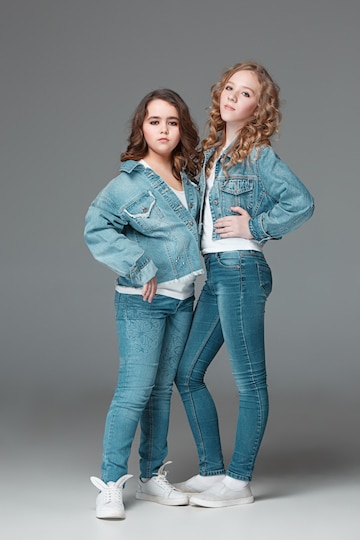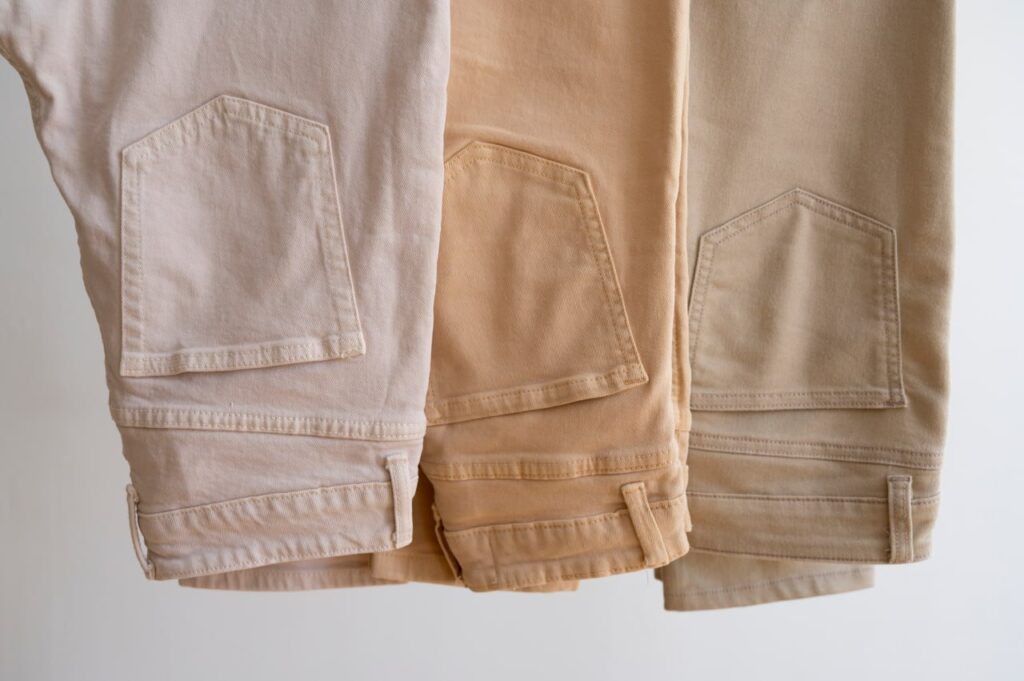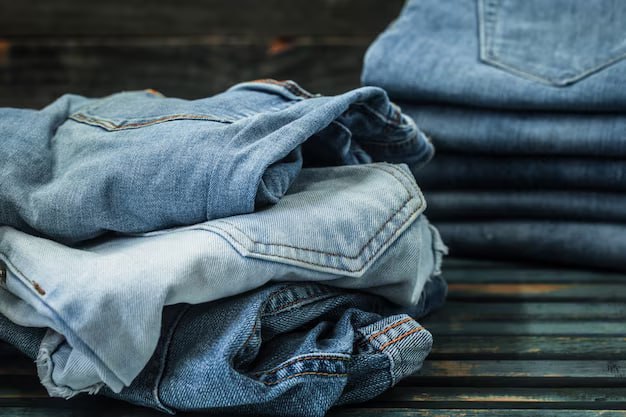The terms “denim” and “jeans” are often confused worldwide and often used interchangeably despite their differences. To be clear, all jeans are made from denim, but not all are made from jeans. Specifically, denim and fabric for jeans. This 100% cotton twill material can also be made into various products and garments, such as bags, blouses, skirts, and jackets. Let us examine the difference between these two terms in more detail.
In this comparison, we will explore the main differences between denim and jeans. We will also explore their unique characteristics and offer advice on how to care for them to maximize their longevity. Without further ado, let’s dive into it.
SilkSageTextiles helps you ensure the Importance of Quality and Finishing in Denim Products. The most important factors in this regard are the color and fabric of the jeans. The first tip is not to pair dark jeans with a light color as it can change its intensity. In addition, care should be taken with lightweight materials, as wet black clothes can discolor.
Jeans have a long life in terms of durability if not washed frequently. Since the color and quality of these fabrics can deteriorate over time, they should not be maintained frequently. Wearing multiple pairs of jeans as opposed to just one can be part of the solution.

Jeans
Generally, jeans are worn as a type of clothing by all the older individuals in today’s society. In the second half of the 19th century, Levi Strauss created the first jeans, copper riveted cotton pants. Because of their stylish appearance, jeans are very popular today.
Jeans are clothes that can be worn by people of all ages and backgrounds. As can be seen from the fact that their closets are filled with two pairs of jeans at any given time, today’s students cannot function without the basic five-pocket pair of jeans. Although other colors of jeans are produced today, blue is the unique color offered by jeans.
Jeans are considered comfortable clothes for casual men and women. The main material for jeans is denim, although there are hundreds of different types. We offer regular fits, skinny fits, and slim fits among others. Both wet and dry denim are treated to a stylish finish. Dry denim plays off tight jeans, while wet denim makes jeans soft. Because they are tough and do not easily collect stains, men especially love tight jeans.
No one will be seen without jeans. Because they rarely need maintenance, they are popular. It’s all due to the unique quality of the denim material, which gives the jeans a higher quality. However, there are low-quality imitated types of denim on the market.

Care Instruction For Jeans
The most important factors in this regard are the color and fabric of the jeans. The first tip is not to pair dark jeans with a light color as it can change its intensity. In addition, care should be taken with lightweight materials, as wet black clothes can discolor.
Jeans have a longer lifespan in terms of durability if they are not washed frequently. Since the color and quality of these fabrics can deteriorate over time, they should not be maintained frequently. Wearing multiple pairs of jeans as opposed to just one can be part of the solution.
Denim
A fabric that can be made from stretch twill or 100% twill denim versus cotton. The warp yarn of the denim is blue cotton and the filling yarn is white cotton. Together they contribute to a strong twill with curved parallel lines. Worldwide, denim fabric is used to make a variety of products such as jeans, jackets, shirts, bags, and purses for men and women of all ages.
The durable heavy cotton twill of 100% cotton is what gives the denim its character. The blue and white cotton used for warp yarn for denim fabric has a variety of blue and white diagonal parallel lines that must go through several steps before becoming a finished product, and can even be dyed to a desired color.
Both wet and dry denim are available. Thin, soft jeans are made from wet denim. These jeans tend to feel silky, but not as tight as dry denim.
Dry denim, on the other hand, is done after the fabric is washed after it dies. As a result, the material is gradually becoming harder and is used to make jeans that are as tight as regular fit.

What Is Denim Made From?
Although there are many cotton blend fibers, all denim is generally made from cotton, yarn, and mill-finished. The durability of denim has been proven through years of use in the clothing trade, especially in the manufacture of overalls and pants suitable for work.
Care Guidelines For Denim
Be sure to thoroughly review the care instructions before washing your denim garments or accessories. Most of the blue dye can be transferred during washing, so wash the denim with complementary colors or alone during the first wash.
Denim should be washed in cold water on a moderate to regular cycle. Denim can be dried in a drying room; The heating system should be centralized. To extend the life of a denim shirt, you should hang it out to dry and wash it only after several uses.

6 Key Differences of Denim vs. Jeans
Simply put, the difference between denim and jeans is that one is a fabric and the other is an article of clothing. Jackets, overalls, shirts, and jeans are just a few examples of the many garments made from denim. Denim fabric is often used to create the look of jeans.
Jeans are sometimes made of cotton, which makes them lighter and more breathable than rigid denim.

1: Definition: Denim vs. Jeans
When cotton fibers are spun and dyed brown, then woven into the fabric, denim is made. Denim fabric is often used to make a type of clothing called jeans.
2: Fabric Composition: Denim vs. Jeans
100% cotton is used for the denim. The fabric is woven with a twill weave. Although jeans are most commonly made from denim, denim can also be made from a variety of synthetic materials.
3: Longevity: Denim vs. Jeans
The denim is made from 100% cotton twill for durability. Because they are made of fabric, jeans are also durable. However, the method can affect the duration of use. Compared to denim, denim is more flexible.
4: Shade: Denim vs jeans
The weft thread on the back of the denim fabric is white, while the warp thread on the front is blue. Jeans can be made in many colors and colors.
5: Mass: Denim vs jeans
Unlike the short jeans that it is, denim is an important accessory. Because they have to be worn repeatedly, jeans are designed to be lightweight. The weight varies depending on the design. The sturdy one made of dried denim is very heavy and is good to wear in the winter.
6: Utilizations: Denim vs jeans
Besides bags, purses, blouses, and skirts, denim is used to make jeans and many other accessories. Denim fabric products include jeans and others. Then, of course, jeans are the clothes you wear for casual purposes, and it is mandatory to choose the perfect denim shirt for any occasion you visit. Work clothes are scarce for them. Jeans are popular for their low maintenance. Each time you wear it, you don’t need to iron it.
Decoding Style: Pants vs. Slacks
In American English, pants are two-piece outerwear. Known as slacks, the pants are unflattering and tend to be loose cut and emphasize women’s fashion.
Usually, these two terms refer to menswear, however, some women’s styles may use slacks due to their universality.
These terms also have different definitions describing different structures. They can choose from jeans, dungarees, waders, khakis, and other styles.

All About Slacks
In American English English, the word “pants” is used to describe any pair of pants associated with formal clothing or semi-clothing. Runners, sweatpants, and other modern sportswear options are not included.
Both men and women can wear formal and casual pants, called “slacks”. While most slacks are casual wear, they shouldn’t be worn to work because they don’t go with a tie or formal shirt. Slacks are relatively casual and considered yesterday, so younger generations choose to wear pants instead. Slack is also made of shiny polyester material instead of cotton.
Therefore, these slacks are not suitable for a standard environment. Slacks, however, are incredibly comfortable, and comfortable to wear. Both men and women wear sandals, although women wear them more than men.
If you wear slacks, you will have a comfortable pair of pants that will fit in most situations. The word is derived from an old Saxon word meaning “loose”. When worn, it may be too tight and inflexible.
Most pants are made from wool. Giving the product plenty of breathability, it avoids feeling heavy or oppressive. While some industries use the term to describe some traditional options, these strategies tend to be more informal. The main distinctive feature of the slacks is their lightweight design.

All About Pants
Trousers are called “pants” in the United States and many other countries. It is a garment worn throughout Western culture, including Commonwealth countries that were formerly part of the British Empire and places like South Asia, China, Japan, and even Korea where men dress traditionally, pants became the most popular because it was comfortable and convenient It covers the hips.
Pants can be made from a wide variety of denim and jeans materials, but cotton is the material of choice because of its ease and breathability. In addition, pants with and without pleats are available to cater to different demographic groups. Because they don’t require a great deal of ironing, woolless pants have now become fashionable.
Because the jeans can be worn by both men and women, they are considered unisex clothing. However, women’s pants have different colors, textures, and fits as compared to men’s pants.

♦ Breaking it Down: Pants vs. Jeans
The term for all types of trousers used by both men and women focuses on pants and jeans, which are a type of trousers made of thick twill called denim The difference between pants and jeans are simple materials when they are compared. Compared to casual-looking jeans, pants are standard.
Here are a few differences between pants and jeans.
♦ Fabric
While cotton is the most popular fabric for both regular and casual pants, pants are made from all kinds of fabrics Cotton, linen, wool, and silk are natural fibers and trousers examples. Man-made fibers include materials such as nylon, polyester, rayon, leather, and acrylics. In contrast, denim is a durable and durable cotton warp-faced twill fabric used to make jeans.
♦ Type
Pants refer to a fairly broad range of underwear including jeans, although jeans vs pants are all important clothing worn to cover the lower body with specific areas for each leg American culture sees pants as any lower body covering the bottom, while British culture sees pants as underwear.
High-waisted pants that stay on the floor for a long time are called “jeans” in all styles.
Style
There are many types of pants available depending on the event you have, your style, and the type of work you do. Chinos are a timeless accessory that comes in a wide range of colors for any casual outdoor occasion, especially in the summer.
Many more types of trousers can be worn for situations, including drawstring, drawstring pants, corduroy, boots, cargo pants, track pants, slacks, shorts, khakis, and joggers.

Longevity
Denim is a strong and flexible cotton twill that has been used for decades to make heavy pants and overalls for heavy-duty applications requiring durability. The material for jeans Denim has long been considered Denim as workwear which is difficult because of its flexibility and versatility. In contrast, pants are not as tight and durable as denim jeans.

1: Why is it called jeans, not denim?
The word jeans come from ‘Genoa Fustian’, a cotton twill fabric; It is often used for thick work clothes. Workers in America called their work clothes ‘ jeans,’ after the city of Genoa where they were originally made.
2: Are jeans real denim?
Traditionally, jeans are made of denim. Denim is a durable, 100% cotton fabric that darts down at least two warp threads to create a unique diagonal twill pattern. This makes the denim fabric stronger than other materials by using one simple fabric.
3: Is denim 100% cotton?
The fabric of modern denim jeans is unique. Denim jeans are 100% cotton, 60% cotton/40% polyester, 50% cotton/50% polyester, and 60% polyester/40% cotton. Some types of denim for jeans are a blend of cotton, nylon, and polyester. Each fabric wears differently, but all are easy.


